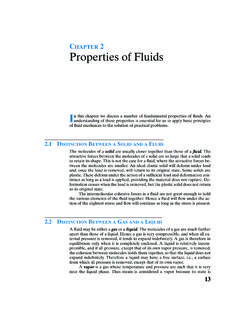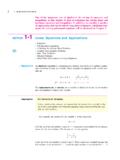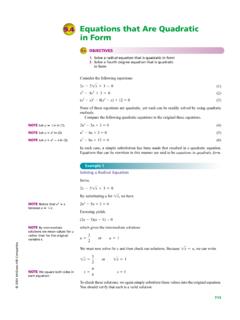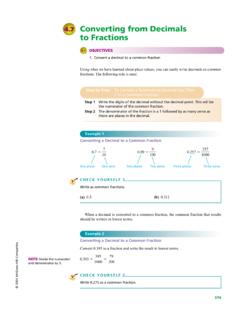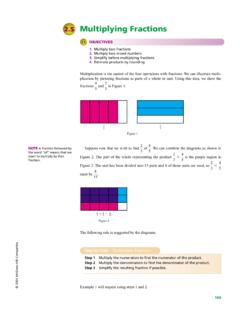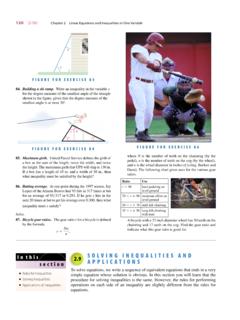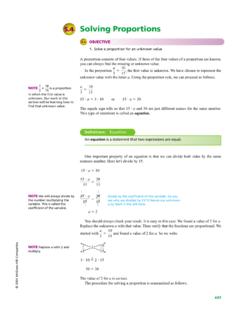Transcription of 6.1 Introduction to Polynomials and Polynomial Functions
1 Introduction to Polynomials and Polynomial Functions OBJECTIVES. 1. Identify like terms 2. Find the degree of a Polynomial 3. Find an ordered pair associated with a given Polynomial function In Chapter 4, we looked at a class of Functions called linear Functions . In this section, we examine Polynomial Functions . We begin by defining some important words. Definitions: Term A term is a number or the product of a number and one or more variables, raised to a power. Example 1. Identifying Terms Which of the following are terms? 5x3 2x2 3x 4xy 5x and 4xy are terms. 2x2 3x is not a term; it is the sum of two terms. 3. CHECK YOURSELF 1. Which of the following are terms? (a) 5xy (b) 4x3 2y (c) 2x3y2 (d) x7. If terms contain exactly the same variables raised to the same powers, they are called like terms. Examples include 6s and 7s, 4x2 and 9x2, and 7xy2z3 and 10xy2z3.
2 The following are not like terms Different variables 6s and 7t Different exponents 4x2 and 9x3. Different exponents 2001 McGraw-Hill Companies .. 2 3 3 2 3. 7x y z and 10xy z Example 2. Identifying Like Terms For each of the following pairs of terms, decide whether they are like terms. (a) 5x3 and 5x2. Not like terms different exponents 379. 380 CHAPTER 6 Polynomials AND Polynomial Functions . (b) 3xy and 2xy Like terms (c) 4xy2z and 9xy2z Like terms (d) 2xy2 and 7x2y Not like terms different exponents (e) 3x2y and 2x2z Not like terms different variables CHECK YOURSELF 2. For each of the following pairs of terms, decide whether they are like terms. 1 3. (a) 2ab2c and 3ab2d (b) 4xy3 and xy 2. (c) 5x2y3z 2 and 7x3y2z 2 (d) 3x and 4xy A Polynomial consists of one or more terms in which the only allowable exponents are the whole numbers, 0, 1, 2, 3.
3 And so on. The terms are connected by addition or sub- traction signs. Certain Polynomials are given special names according to the number of terms that they have. NOTE The prefix mono A Polynomial with one term is called a monomial. For example, means one. 7x3 2x2y3 4xy 12. are all Polynomials . But, 9. 5 1x x are not Polynomials because the variable in the first term is in the denominator and the vari- able in the second term is under the radical (we will see in Chapter 8 that the exponent in 1. this case is ). 2. A Polynomial with two terms is a binomial. A Polynomial with three terms is called a NOTE The prefix bi means trinomial. two and tri means three. The numerical factor in a term is called the numerical coefficient, or more simply the coefficient, of that term. For example, in the terms 8x4 9x3y4 6x2y7 10xy 2001 McGraw-Hill Companies the numerical coefficients are 8, 9, 6, and 10.
4 Example 3. Classifying Polynomials Which of the following are Polynomials ? Classify the Polynomials as monomial, binomial, or trinomial. Introduction TO Polynomials AND Polynomial Functions SECTION 381. (a) 5x2y Monomial (b) 3m 5n Binomial (c) 4a3 3a 2. Trinomial 2. NOTE Remember that (d) 5y2 . x 1. x 1 2. x 5y2 is not a Polynomial because the variable x is in the denominator. x CHECK YOURSELF 3. Which of the following are Polynomials ? Classify the Polynomials as monomial, binomial, or trinomial. (a) 5x2 6x (b) 8x5. 3. (c) 5x3 3xy 7y2 (d) 9x . x It is also useful to classify Polynomials by their degree. Definitions: Degree of Monomials The degree of a monomial is the sum of the exponents of the variable factors. Example 4. Determining the Degree of a Monomial (a) 5x2 has degree 2. (b) 7n5 has degree 5. (c) 3a2b4 has degree 6. (The sum of the powers, 2 and 4, is 6.)
5 (d) 9 has degree 0 (because 9 9 1 9x0). 2001 McGraw-Hill Companies CHECK YOURSELF 4. Give the degree of each monomial. (a) 4x2 (b) 7x3y2. (c) 8p2s (d) 5. 382 CHAPTER 6 Polynomials AND Polynomial Functions . Definitions: Degree of Polynomials The degree of a Polynomial is that of the term with the highest degree. Example 5. Determining the Degree of a Polynomial (a) 7x3 5x2 5 has degree 3. (b) 5y7 3y2 5y 7 has degree 7. (c) 4a2b3 5abc2 has degree 5 because the sum of the variable powers in the term with highest degree (4a2b3) is 5. Polynomials such as those in Examples 5(a) and 5(b) are called Polynomials in one variable, and they are usually written in descending form so that the power of the variable decreases from left to right. In that case, the coefficient of the first term is called the lead- ing coefficient. CHECK YOURSELF 5.
6 Give the degree of each Polynomial . For those Polynomials in one variable, write in descending form and give the leading coefficient. (a) 7x4 5xy 2 (b) 5 (c) 4x2 7x3 8x 5. A Polynomial function is a function in which the expression on the right-hand side is a Polynomial expression. For example, f(x) 3x3 2x2 x 5. g(x) 2x3 5x 1. P(x) 2x7 2x6 x3 2x4 5x2 6. are all Polynomial Functions . Because they are Functions , every x value determines a unique ordered pair. Example 6. Finding Ordered Pairs Given f(x) 3x3 2x2 x 5 and g(x) 2x3 5x 1, find the following ordered pairs. (a) (0, f(0)). 2001 McGraw-Hill Companies To find f(0), we substitute 0 for x in the function f(x) 3x3 2x2 x 5. f(0) 3(0)3 2(0)2 (0) 5. 0 0 0 5. 5. Therefore, (0, f(0)) (0, 5). Introduction TO Polynomials AND Polynomial Functions SECTION 383. (b) (2, f(2)). f(2) 3(2)3 2(2)2 (2) 5.
7 24 8 2 5. 35. Therefore, (2, f(2)) (2, 35). (c) ( 2, f( 2)). f( 2) 3( 2)3 2( 2)2 ( 2) 5. 24 8 2 5. 9. Therefore, ( 2, f( 2)) ( 2, 9). (d) (0, g(0)). g(0) 2(0)3 5(0) 1. 1. Therefore, (0, g(0)) (0, 1). (e) (2, g(2)). g(2) 2(2)3 5(2) 1. 16 10 1. 5. Therefore, (2, g(2)) (2, 5). (f) ( 2, g( 2)). g( 2) 2( 2)3 5( 2) 1. 16 10 1. 7. Therefore, ( 2, g( 2)) ( 2, 7). CHECK YOURSELF 6. 2001 McGraw-Hill Companies Given f(x) x 3 7x 1 and g(x) x 3 2x 2 3x 4, find the following ordered pairs. (a) (0, f(0)) (b) (2, f(2)). (c) ( 2, f( 2)) (d) (0, g(0)). (e) (2, g(2)) (f) ( 2, g( 2)). 384 CHAPTER 6 Polynomials AND Polynomial Functions . CHECK YOURSELF ANSWERS. 1. (a) Term; (b) not a term; (c) term; (d) term 2. (a) Not like terms; (b) like terms; (c) not like terms; (d) not like terms 3. (a) Binomial; (b) monomial; (c) trinomial; (d) not a Polynomial 4. (a) 2; (b) 5; (c) 3; (d) 0.
8 5. (a) Degree is 4; (b) degree is 0; (c) degree is 3, 7x3 4x2 8x 5, leading coefficient is 7. 6. (a) (0, 1); (b) (2, 5); (c) ( 2, 7); (d) (0, 4); (e) (2, 6); (f) ( 2, 2). 2001 McGraw-Hill Companies Name Exercises Section Date Which of the following expressions are Polynomials ? 3 ANSWERS. 1. 7x3 2. 5x3 . x 1. 2. 3. 4x4y2 3x3y 4. 7. 3. 4. 5. 7 6. 4x3 x 5. 6. 3 x 7. 8. 5a2 2a 7 7. x2. 8. For each of the following Polynomials , list the terms and the coefficients. 9. 9. 2x2 3x 10. 5x3 x 10. 11. 11. 4x3 3x 2 12. 7x2 12. 13. For each of the following pairs of terms, decide whether they are like terms. 14. 13. 3xy2c and 2xy2c 14. 5xy3 and 4xy3 15. 16. 15. 6xy and 2x2y2 16. 3x3y4 and 2x4y3 17. 18. Classify each of the following as a monomial, binomial, or trinomial where possible. 19. 17. 7x3 3x2 18. 4x7 20. 2001 McGraw-Hill Companies 21. 22.
9 19. 7y2 4y 5 20. 2x2 3xy y2. 5. 21. 2x4 3x2 5x 2 22. x4 7. x 385. ANSWERS. 23. 23. 6y8 24. 4x4 2x2 5x 7. 24. 25. 3. 25. x5 26. 4x2 9. 26. x2. 27. Arrange in descending-exponent form if necessary, and give the degree of each 28. Polynomial . 29. 27. 4x5 3x2 28. 5x2 3x3 4. 30. 31. 29. 7x7 5x9 4x3 30. 2 x 32. 33. 31. 4x 32. x17 3x4. 34. 35. 33. 5x2 3x5 x6 7 34. 5. 36. 37. Find the values of each of the following Polynomials for the given values of the variable. 38. 35. 6x 1; x 1 and x 1 36. 5x 5; x 2 and x 2. 39. 40. 37. x3 2x; x 2 and x 2 38. 3x2 7; x 3 and x 3. 41. 42. 39. 3x2 4x 2; x 4 and x 4 40. 2x2 5x 1; x 2 and x 2. 43. 44. 45. 41. x2 2x 3; x 1 and x 3 42. x2 5x 6; x 3 and x 2. 2001 McGraw-Hill Companies 46. Indicate whether each of the following statements is always true, sometimes true, or never true. 43. A monomial is a Polynomial .
10 44. A binomial is a trinomial. 45. The degree of a trinomial is 3. 46. A trinomial has three terms. 386. ANSWERS. 47. 47. A Polynomial has four or more terms. 48. A binomial must have two coefficients. 48. 49. 49. If x equals 0, the value of a Polynomial 50. The coefficient of the leading term in 50. in x equals 0. a Polynomial is the largest coefficient of the Polynomial . 51. (a). (b). (c). (d). (e). In exercises 51 to 58, the Polynomial Functions f(x) and g(x) are given. Find the ordered (f). pairs (a) (0, f(0)), (b) (2, f(2)), (c) ( 2, f( 2)), (d) (0, g(0)), (e) (2, g(2)), and 52. (a). (f) ( 2, g( 2)) (b). (c). (d). (e). (f). 51. f(x) 2x2 3x 5 and g(x) 4x2 5x 7. 53. (a). (b). (c). (d). (e). 52. f(x) 3x2 7x 9 and g(x) 7x2 8x 9. (f). 54. (a). (b). (c). 53. f(x) x3 8x2 4x 10 and g(x) 3x3 4x2 5x 3 (d). (e). (f). 55. (a). (b). 54. f(x) x3 3x2 7x 8 and g(x) 2x3 4x2 9x 2 (c).

